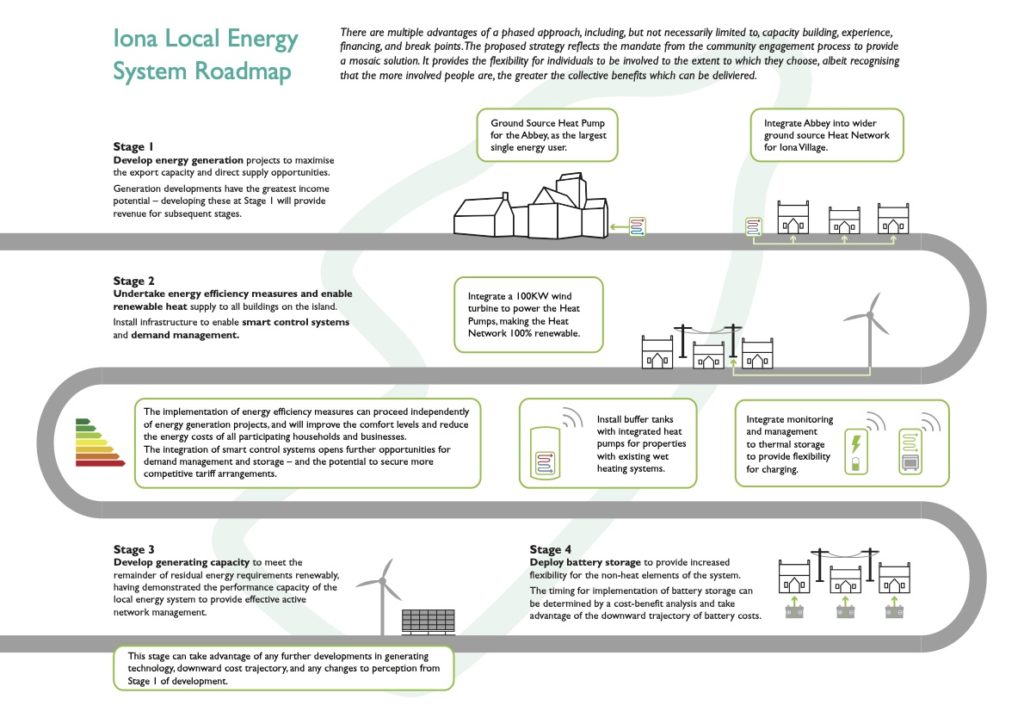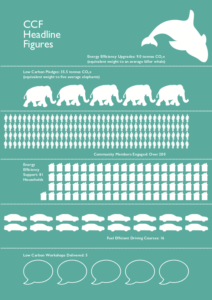Maximising Local Energy Generation, Storage and Use

Iona Renewables has developed a local energy Roadmap that lays out a vision for how a community-led scheme can work towards owning, generating, storing and using energy on the island. There are five high impact first phase projects:
-
-
Improving carbon literacy and carbon-saving actions for residents and visitors
-
Upgrading energy efficiency of buildings on the island
-
Developing and installing a low carbon heat supply for Iona Abbey
-
Developing and installing a low carbon heat supply for Iona Village
-
Investigating generation of renewable electricity for buildings on the island.
-
The studies to shape Iona’s energy transition have been broad in scope and all viable renewable energy generation technologies have been assessed, along with energy storage and demand management options. The energy Roadmap takes an evidence-based approach in identifying and phasing development, with a focus on deliverable and scalable projects.
Iona Renewables is being supported through this initial phase of it’s growth by the Scottish Government’s Strengthening Communities Programme and Investing in Communities Fund.
Iona Heat Network

In 2016, Iona Renewables identified potential to decarbonise the heat supply on the island of Iona and began to take forward feasibility work for a ground source Heat Network. In the period covered by this report Iona Renewables significantly developed the Network, including establishing and handing over responsibility to its wholly owned trading subsidiary, Iona Energy Ltd. Within less than two years — as of 31 March 2018 — £1.65 million capital funding has been secured for Iona Energy Limited to install, own and operate the Network. A further ~£150K is being raised through interest free loans for businesses and direct investment by the Council, bringing total project capital funding to ~£1.795 million. The Heat Network is being developed as a community owned asset, with surpluses in due course to be gifted by Iona Energy Ltd. to Iona Renewables in support of its charitable objectives.
The Heat Network started as two first-phase high-impact projects to supply renewable heat to a) Iona Abbey and b) Iona Village, which are now being progressed as a single project. Overall, the Heat Network will:
-
-
Contribute to lower-carbon more sustainable living conditions enabling buildings to be heated more effectively and affordably, including, where possible, improving energy efficiency;
-
Support a cross-island breakthrough on fuel poverty through delivering cost savings for end users — levels aren’t precisely
known (IR has data on household expenditure on energy, but not yet on household income) but are expected to be significantly higher than the 40% Argyll average (Iona is not connected to the gas grid, depends instead on off-peak electric or oil heating, with exceptionally high fuel transport costs, and is an exposed location with poor quality pre-1950s housing stock); -
Cut carbon emissions by an estimated 152 tonnes CO2e annually, with potential to save a further 90 tonnes/year if renewable electricity is used to run the heat pumps in the future;
-
Further increase carbon literacy and sustained carbon-saving behaviours, evidenced e.g., by 100% sign up to energy efficiency surveys and 100% sign up to commitment in principle to join the Heat Network;
-
Support creation of employment, e.g., directly linked to potentially supply and maintenance of renewable heat and electricity; and indirectly through boosting of businesses via enhancing and marketing Iona’s brand as a ‘green’ island with several ‘green tourism’ venues, plus provision of affordable heat at better temperatures enabling a longer visitor season and better visitor experience;
-
Advance community development by generating income for community benefit;
-
Enable the community after 15 years (depending on final funding terms) to own its own heat supply, directly supporting community empowerment. Collectively, around £46,000 will be retained within the local economy each year rather than exiting to the mainland.
-
The Heat Network has been supported for feasibility by CARES. Confirmed project funding thus far is from: Scottish Government District Heating Loan Fund and Scottish Energy Efficiency Programme; Social Investment Scotland; Esmee Fairbairn Foundation; Russell Trust; Pebble Trust; The Waterfall Fund; and direct funding from Argyll and Bute Council for Council buildings, as well as Resource Efficient Scotland for interest free loans for business.
Electricity Generation

Iona Renewables’ original feasibility study (2016–17) investigated all possible options — wind, solar, biomass, hydro — for renewable electricity generation. The only viable potential option is wind energy which would be taken forward subject to community support, and to addressing technical and regulatory challenges.
The feasibility work identified a Heat Network powered by a community owned wind turbine as an efficient and cost-effective option, and one that could in due course enable the Heat Network to be 100% renewable and a leading example of a Local Energy System. Wind energy and heat pumps operate very effectively together. Heat Pumps can use the electrical energy generated by wind to provide the input energy required for heating and hot water. There also tends to be a close correlation between energy generation from wind and demand from heat pumps — buildings tend to need more heat when it is windy (particularly with older, leakier building stock).
Iona Renewables completed a CARES Start Up Grant project to examine potential options for supplying electricity from a turbine directly to the demand requirement on Iona, particularly to meet the concentrated demand of the Heat Network. This direct supply was in place of fully exporting to the grid which would require IR to fund a grid upgrade costing around £1M.
Environmental (including ornithological) surveys were also carried out to assess potential impacts of wind energy, led by the National Trust for Scotland (NTS) Ranger supported by island volunteers. We are very grateful to NTS and the volunteers for all their work, in all weather conditions!
The study demonstrated that the most promising direct supply option would be to pursue a Virtual Private Network (VPN). Incoming proposed changes (April 2018) to the Balancing and Settlement Code would allow multiple connections ‘behind the meter’, allowing customers to get power from a community owned turbine when the energy is available, but also from their regular electricity provider to ensure continuous supply. With a VPN, local tariffs can be created that will bring significant savings to the local community as well as increased profits for the generating assets. The upfront costs to the community would be far less than a Private Wire Network as the system relies most heavily on automation and communications software and hardware that negates the need for significant physical infrastructure. There would also be far less operational burden. Overall, a VPN could be well suited to Iona.
This project has been put on the back burner while we focus on implementing the Heat Network.
Development of options has been supported by CARES.
Energy Efficiency and Carbon Literacy
Iona Renewables implemented a one-year Climate Challenge Fund (CCF) project, ‘Lightening the Load’. The project aimed to increase carbon-awareness and energy efficiency on the island, and was delivered by Iona Renewables in partnership with Edinburgh-based community renewables experts, Scene Connect.
Carbon literacy through workshops and direct engagement, to increase awareness of climate change and promote positive behaviour change;Lightening the Load has focused on several complementary low carbon initiatives, including:
-
-
Low carbon behaviour change, building on improved carbon literacy — e.g. sustainable food consumption, waste reduction, low carbon travel, etc.;
-
Access to energy efficiency expertise and facilitation of energy efficiency works, delivered through partnerships with others, including Home Energy Scotland and Argyll & Bute Council.
-
Progress on energy efficiency was particularly challenging. However, the project helped to expose clear deficiencies within home energy efficiency assessment, funding and referral processes, whilst informing a new model for energy efficiency deployment which pays closer attention to local context. The fact of having CCF support also greatly encouraged the main agencies to listen seriously to the problems identified through the project and to try to make system-wide improvements
Energy Efficiency was supported by CCF with Argyll and Bute Council Home Energy Efficiency Programme Area Based Scheme (HEEPS ABS), Home Energy Scotland, Resource Efficient Scotland and Scottish Energy Efficiency Programme (SEEP).

